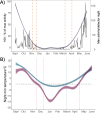The importance of peripheral populations in the face of novel environmental change
- PMID: 39772955
- PMCID: PMC11706656
- DOI: 10.1098/rspb.2024.2331
The importance of peripheral populations in the face of novel environmental change
Abstract
Anthropogenically driven environmental change has imposed substantial threats on biodiversity, including the emergence of infectious diseases that have resulted in declines of wildlife globally. In response to pathogen invasion, maintaining diversity within host populations across heterogenous environments is essential to facilitating species persistence. White-nose syndrome is an emerging fungal pathogen that has caused mass mortalities of hibernating bats across North America. However, in the northeast, peripheral island populations of the endangered northern myotis (Myotis septentrionalis) appear to be persisting despite infection while mainland populations in the core of the species range have experienced sharp declines. Thus, this study investigated host and environmental factors that may contribute to divergent population responses. We compared patterns of pathogen exposure and infection intensity between populations and documented the environmental conditions and host activity patterns that may promote survival despite disease invasion. For island populations, we found lower prevalence and less severe infections, possibly due to a shorter hibernation duration compared to the mainland, which may reduce the time for disease progression. The coastal region of the northern myotis range may serve as habitat refugia that enables this species to persist despite pathogen exposure; however, conservation efforts could be critical to supporting species survival in the long term.
Keywords: host persistence; host–pathogen interactions; northern myotis; peripheral populations; refugia from disease; white-nose snydrome.
Conflict of interest statement
We declare we have no competing interests.
Figures




Similar articles
-
Effects of white-nose syndrome on regional population patterns of 3 hibernating bat species.Conserv Biol. 2016 Oct;30(5):1048-59. doi: 10.1111/cobi.12690. Epub 2016 Jul 18. Conserv Biol. 2016. PMID: 26872411
-
Host and pathogen ecology drive the seasonal dynamics of a fungal disease, white-nose syndrome.Proc Biol Sci. 2015 Jan 22;282(1799):20142335. doi: 10.1098/rspb.2014.2335. Proc Biol Sci. 2015. PMID: 25473016 Free PMC article.
-
Drivers of variation in species impacts for a multi-host fungal disease of bats.Philos Trans R Soc Lond B Biol Sci. 2016 Dec 5;371(1709):20150456. doi: 10.1098/rstb.2015.0456. Philos Trans R Soc Lond B Biol Sci. 2016. PMID: 28080982 Free PMC article.
-
A Palearctic view of a bat fungal disease.Conserv Biol. 2025 Feb;39(1):e14265. doi: 10.1111/cobi.14265. Epub 2024 Apr 15. Conserv Biol. 2025. PMID: 38616727 Free PMC article. Review.
-
Investigating and managing the rapid emergence of white-nose syndrome, a novel, fatal, infectious disease of hibernating bats.Conserv Biol. 2011 Apr;25(2):223-31. doi: 10.1111/j.1523-1739.2010.01638.x. Epub 2011 Feb 1. Conserv Biol. 2011. PMID: 21284732 Review.
References
MeSH terms
Supplementary concepts
Grants and funding
LinkOut - more resources
Full Text Sources

